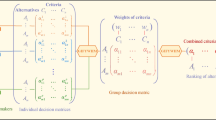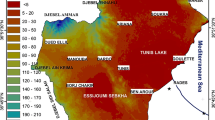Abstract
As the evolution of emergencies is often uncertain, it may lead to multiple emergency scenarios. According to the characteristics of emergency management, this paper proposes an emergency decision support method by using the probabilistic linguistic preference relations (PLPRs) whose elements are the pairwise comparisons of alternatives given by the decision-makers (DMs) in the form of probabilistic linguistic term sets (PLTSs). As the decision data are limited, it is difficult for the DMs to provide exact occurrence probabilities of all possible emergency scenarios. Thus, we propose a probability correction method by using the computer-aided tool named the case-based reasoning (CBR) to obtain more accurate and reasonable occurrence probabilities of the probabilistic linguistic elements (PLEs). Then, we introduce a multiplicative consistency index to judge whether a PLPR is consistent or not. Afterwards, an acceptable multiplicative consistency-based emergency decision support method is proposed to get more reliable results. Furthermore, a case study about the emergency decision making in a petrochemical plant fire accident is conducted to illustrate the proposed method. Finally, some comparative analyses are performed to demonstrate the feasibility and effectiveness of the proposed method.



Similar content being viewed by others
References
Zadeh LA (1975) The concept of a linguistic variable and its application to approximate reasoning-I. Inf Sci 8(3):199–249
Gao J, Xu ZS, Liao HC (2017) A dynamic reference point method for emergency response under hesitant probabilistic fuzzy environment. Int J Fuzzy Syst 19(5):1261–1278
Xu ZS (2004) Uncertain linguistic aggregation operators based approach to multiple attribute group decision making under uncertain linguistic environment. Inf Sci 168(1):171–184
Herrera F, Martinez L (2000) A 2-tuple fuzzy linguistic representation model for computing with words. IEEE Trans Fuzzy Syst 8(6):746–752
Xu ZS, Wang H (2017) On the syntax and semantics of virtual linguistic terms for information fusion in decision making. Inf Fusion 34:43–48
Rodriguez RM, Martinez L, Herrera F (2012) Hesitant fuzzy linguistic term sets for decision making. IEEE Trans Fuzzy Syst 20(1):109–119
Pang Q, Xu ZS, Wang H (2016) Probabilistic linguistic term sets in multi-attribute group decision making. Inf Sci 369:128–143
Zhang GQ, Ma J, Lu J (2009) Emergency management evaluation by a fuzzy multi-criteria group decision support system. Stoch Env Res Risk Assess 23(4):517–527
Zhou Q, Huang WL, Zhang Y (2011) Identifying critical success factors in emergency management using a fuzzy DEMATEL method. Saf Sci 49(2):243–252
Li Y, Hu Y, Zhang XG, Deng Y, Mahadevan S (2014) An evidential DEMATEL method to identify critical success factors in emergency management. Appl Soft Comput 22:504–510
Zhou XY, Shi YQY, Deng XY, Deng Y (2017) D-DEMATEL: a new method to identify critical success factors in emergency management. Saf Sci 91:93–104
Ju YB, Wang AH, Liu XY (2012) Evaluating emergency response capacity by fuzzy AHP and 2-tuple fuzzy linguistic approach. Expert Syst Appl 39(8):6972–6981
Xu YJ, Ma F, Xu WJ, Wang HM (2015) An incomplete multi-granular linguistic model and its application in emergency decision of unconventional outburst incidents. J Intell Fuzzy Syst 29(2):619–633
Herrera-Viedma E, Martinez L, Mata F, Chiclana F (2005) A consensus support system model for group decision-making problems with multigranular linguistic preference relations. IEEE Trans Fuzzy Syst 13:644–658
Liu Y, Fan ZP, Zhang X (2016) A method for large group decision-making based on evaluation information provided by participators from multiple groups. Inf Fusion 29:132–141
Liu PD, Teng F (2018) Some Muirhead mean operators for probabilistic linguistic term sets and their applications to multiple attribute decision-making. Appl Soft Comput J. https://doi.org/10.1016/j.asoc.2018.03.027
Dong YC, Xu YF, Yu S (2009) Linguistic multiperson decision making based on the use of multiple preference relations. Fuzzy Sets Syst 160:603–623
Zhang YX, Xu ZS, Wang H, Liao HC, Consistency-based risk assessment with probabilistic linguistic preference relation. Appl Soft Comput 49 (2016) 817–833
Zhang YX, Xu ZS, Liao HC (2017) A consensus process for group decision making with probabilistic linguistic preference relations. Inf Sci 414:260–275
Alonso S, Chiclana F, Herrera F, Herrera-Viedma E, Alcalá-Fdez J (2008) A consistency-based procedure to estimate missing pairwise preference values. Int J Intell Syst 23(2):155–175
Wang H, Xu ZS (2016) Interactive algorithms for improving incomplete linguistic preference relations based on consistency measures. Appl Soft Comput 42:66–79
Xia MM, Xu ZS, Wang Z (2014) Multiplicative consistency-based decision support system for incomplete linguistic preference relations. Int J Syst Sci 45(3):625–636
Liao HC, Xu ZS, Xia MM (2014) Multiplicative consistency of hesitant fuzzy preference relation and its application in group decision making. Int J Inf Technol Decis Making 13(01):47–76
Zhang ZM, Wu C (2014) On the use of multiplicative consistency in hesitant fuzzy linguistic preference relations. Knowl Based Syst 72:13–27
Genç S, Boran FE, Akay D, Xu ZS (2010) Interval multiplicative transitivity for consistency, missing values and priority weights of interval fuzzy preference relations. Inf Sci 180(24):4877–4891
Wu J, Chiclana F (2014) Multiplicative consistency of intuitionistic reciprocal preference relations and its application to missing values estimation and consensus building. Knowl Based Syst 71:187–200
Xu ZS, Cai XQ, Szmidt E (2011) Algorithms for estimating missing elements of incomplete intuitionistic preference relations. Int J Intell Syst 26(9):787–813
de Mantaras RL (2001) Case-based reasoning, machine learning and its application. Springer, Berlin, pp 127–145
Aamodt E, Plaza (1994) Case-based reasoning: foundational issues, methodological variations, and system approaches. AI Commun 7:39–59
Liao TW, Zhang Z, Mount CR (1998) Similarity measures for retrieval in case-based reasoning systems. Appl Artif Intell 12(4):267–288
Finnie G, Sun Z (2002) Similarity and metrics in case-based reasoning. Int J Intell Syst 17(3):273–287
Liao HC, Xu ZS, Zeng XJ (2014) Distance and similarity measures for hesitant fuzzy linguistic term sets and their application in multi-criteria decision making. Inf Sci 271:125–142
Orlovsky SA (1978) Decision-making with a fuzzy preference relation. Fuzzy Sets Syst 1:155–167
Tanino T (1984) Fuzzy preference orderings in group decision making. Fuzzy Sets Syst 33(84):117–131
Herrera VE, Chiclana F, Herrera F, Alonso S (2007) Group decision-making model with incomplete fuzzy preference relations based on additive consistency. IEEE Trans Syst Man Cybern 37:176–189
Chiclana F, Herrera-Viedma E, Alonso S, Herrera F (2009) Cardinal consistency of reciprocal preference relations: a characterization of multiplicative transitivity. IEEE Trans Fuzzy Syst 17:14–23
Wang TC, Chen YH (2008) Applying fuzzy linguistic preference relations to the improvement of consistency of fuzzy AHP. Inf Sci 178(19):3755–3765
Dong YC, Xu YF, Li HY (2008) On consistency measures of linguistic preference relations. Eur J Oper Res 189(2):430–444
Zhang GQ, Dong YC, Xu YF (2014) Consistency and consensus measures for linguistic preference relations based on distribution assessments. Inf Fusion 17:46–55
Yu L, Lai KK (2011) A distance-based group decision-making methodology for multi-person multi-criteria emergency decision support. Decis Supp Syst 51(2):307–315
Körte J (2003) Risk-based emergency decision support. Reliab Eng Syst Saf 82(3):235–246
Levy JK, Taji K (2007) Group decision support for hazards planning and emergency management: a Group Analytic Network Process (GANP) approach. Math Comput Model 46(7):906–917
Liu Y, Fan ZP, Zhang Y (2014) Risk decision analysis in emergency response: a method based on cumulative prospect theory. Comput Oper Res 42:75–82
Acknowledgements
This work was funded by the National Natural Science Foundation of China (Nos. 71571123, 71532007, 71771155), and the Major Program of the National Social Science Fund of China (Grant No. 17ZDA092).
Author information
Authors and Affiliations
Corresponding author
Additional information
Publisher’s Note
Springer Nature remains neutral with regard to jurisdictional claims in published maps and institutional affiliations.
Rights and permissions
About this article
Cite this article
Gao, J., Xu, Z., Ren, P. et al. An emergency decision making method based on the multiplicative consistency of probabilistic linguistic preference relations. Int. J. Mach. Learn. & Cyber. 10, 1613–1629 (2019). https://doi.org/10.1007/s13042-018-0839-0
Received:
Accepted:
Published:
Issue Date:
DOI: https://doi.org/10.1007/s13042-018-0839-0




